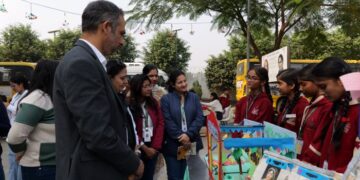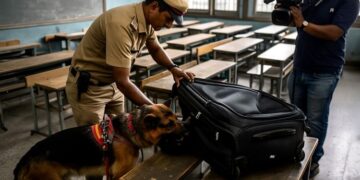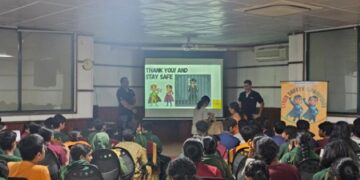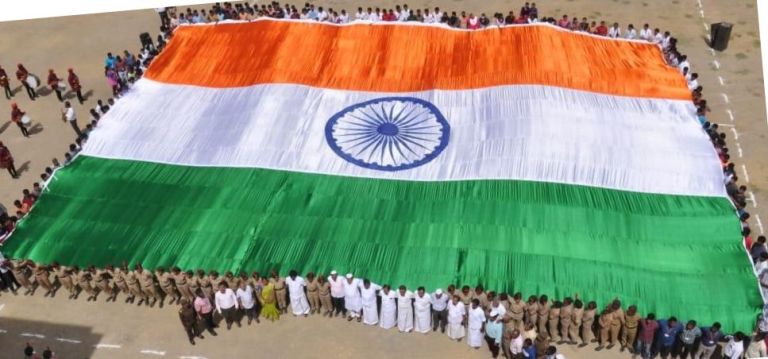The violent ethnic clashes and rioting in the state of Manipur that erupted in early May and continued for almost two months besides leaving over 140 people dead, burnt homes, buildings, shops and other properties including schools, according to reports have displaced 15,203 school going children. Of these 14,297 children staying in relief camps and other places are reported to have been enrolled in nearby schools. Some are also enrolled in schools in other states, including adjoining states like Mizoram and far-off ones like Kerala.
With an all-out effort of the governments, agencies and civil society groups, the situation was brought under control and schools have reopened for classes 9-12 after two months’ closure in the June end and classes 1-8 resumed on 5th July. However, attendance has been low after reopening especially in Churachandpur where violence has been high. In some instances, schools could not reopen since staff was unable to rejoin work for fear of their safety. Fear has prevented many parents from sending their children to schools as instances of violence near schools have amplified concerns.
The RTE Forum, a civil society platform of national education networks, educationist activists, teachers’ unions, peoples’ movements and allied groups, taking note of the serious situation on ground has submitted a detailed representation to the NCPCR and the Parliamentary Standing Committee on the status of school going children and schools in the state of Manipur and “calls upon the state and central government and all other stakeholders to ensure schools are ‘peace zones’, teachers are facilitated to run schools and all children are supported to cope with the trauma and pick up learning.”
Expressing its concern, the Forum in a written submission to the agencies said, “While the government has attempted to restore education, it is critical to ensure that the education system is prepared for the long run to deal with the aftermath of the conflict. In times of conflict, children are often the silent victims. They have faced unprecedented trauma during the crisis and more robust efforts are needed to support them to not only cope with the immediate impact of the conflict but also to build back better. “
Schools in the state are reported to be facing a shortage of supplies and teachers, especially in areas where large numbers of displaced children have been admitted. Furthermore, government sources state that around 100 schools are closed for a range of issues; this includes 72 schools serving classes 1-8 and a further 28 serving classes 9-12. Some schools function as relief camps, others are occupied by security personnel, some have been vandalised and others are in sensitive areas. The highest number of such schools is in Churachandpur, followed by Bishnupur, Kakching, Kangpokpi and Imphal East7 districts; in July, it was reported that approximately, one in six schools in Churachandupur remained closed. However, it has been argued that the number of schools remaining closed may be higher, particularly in areas which remain tense. Thus, it has been argued during the ongoing Supreme Court hearings that 200 schools in tribal areas may be closed. Additionally, some schools have been burned or damaged with reports highlighting incidents as recently as 22nd July. Some sources suggest that it is possible that 11 schools have been burned down in Sugnu.
The government has reported that 93.5 per cent of the displaced students have been readmitted to “the nearest feasible school free of cost” and the requirement of permission for students of class IX to class XII opting to change school has been relaxed for those affected by the violence. Teachers in schools receiving displaced students have reported that the task is complicated as while students are still dealing with the impact of the trauma; linguistic differences and differences in the curricula practised in different districts pose more challenges. Other estimates suggest that the number of children out of school may be higher. Children who have fled their homes have lost access to books, learning materials and key documents that they fear they will need for subsequent admissions in higher education, particularly outside the state. This, along with the internet ban and the overall psychological trauma has disrupted the education of students, particularly those due to have examinations.
In many instances, students have lost documents necessary for admission to higher education institutions and are concerned about their capacity to prepare for Board examinations. The violence has left a deep psychological impact on the mental health of students. While some schools have tried to provide support to students, trained professionals and facilities are not available to deal with the scale of the problem.
The government has established mental help support centres for displaced women and children and grievance redress helplines for people in relief camps have been established and 400 officials deputed to monitor the camps; steps have also been taken to reunite separated children and their parents.
The RTE Forum’s recommendations
While the Manipur government has taken immediate actions to respond to the immediate educational needs of students, further steps including ensure that anti-trafficking units and child protection structures at the village level are functional so that vulnerable children do not go missing or are trafficked, are needed keeping in mind the recovery from the conflict situation. The RTE Forum recommends the following immediate actions:
- Upscale efforts to provide psychosocial interventions and counselling for students and families to ease the trauma.
- Strengthen training, sensitization and counselling for educators in the state to enable them to respond to their own trauma and enable them to respond to the needs of their students.
- All parties should cease attacks on educational institutions and commit to ensuring that schools remain zones of peace. Protocols must be put in place to ensure the safe evacuation of students in cases of violence, particularly in residential schools.
- Immediately vacate schools used for camps to house refugees or other purposes to enable the resumption of education; find alternative spaces and accommodate affected families to enable the resumption of education.
- Facilitate processes of writing exams for displaced students to enable them to continue their education, including those preparing for Board examinations.
- Put in place a process for obtaining duplicate certificates for those who have lost access to the same. 7. Increase the distribution of educational materials and other supplies for displaced students, particularly those residing in camps to ensure a speedy return to normalcy. At the same time, ensure conditions of dignity in relief camps. Ensure uninterrupted supply of mid-day meals, sanitary napkins, and health and hygiene facilities through schools.
- Create registers for children in schools/relief camps to ensure they do not go missing, are safe and under care.
- Allow school-going students who are also caring for their younger siblings, to bring them to school daily. Provide temporary childcare facilities within the school building for young children not enrolled in the school.
- Activate VLCPCs, Village Councils and local Panchayats with the help of civil society groups, women’s groups and youth to ensure that all children, especially girls, are protected while accessing public spaces and schools, no children are missing, and all out-of-school children are enrolled back in school. Involve parents in efforts at every step to both enable them to recover from the trauma and offer support to teachers in providing care and resuming education.
- In places where it is possible, ensure communication between teachers and schoolchildren through telephone calls and home visits.
- Identify, protect and place children found without caregivers and parents in childcare homes.
- Use digital and mass media to promote messages of peace and resilience with content addressing trauma experienced by children.














